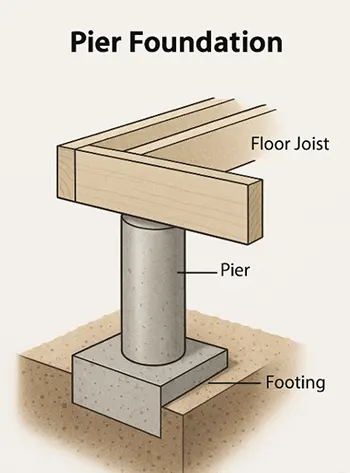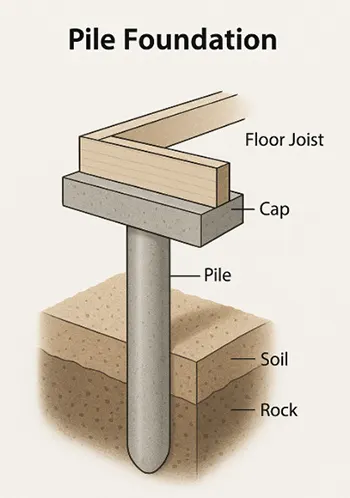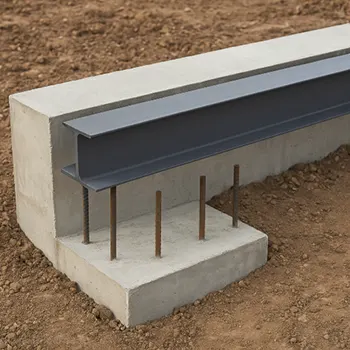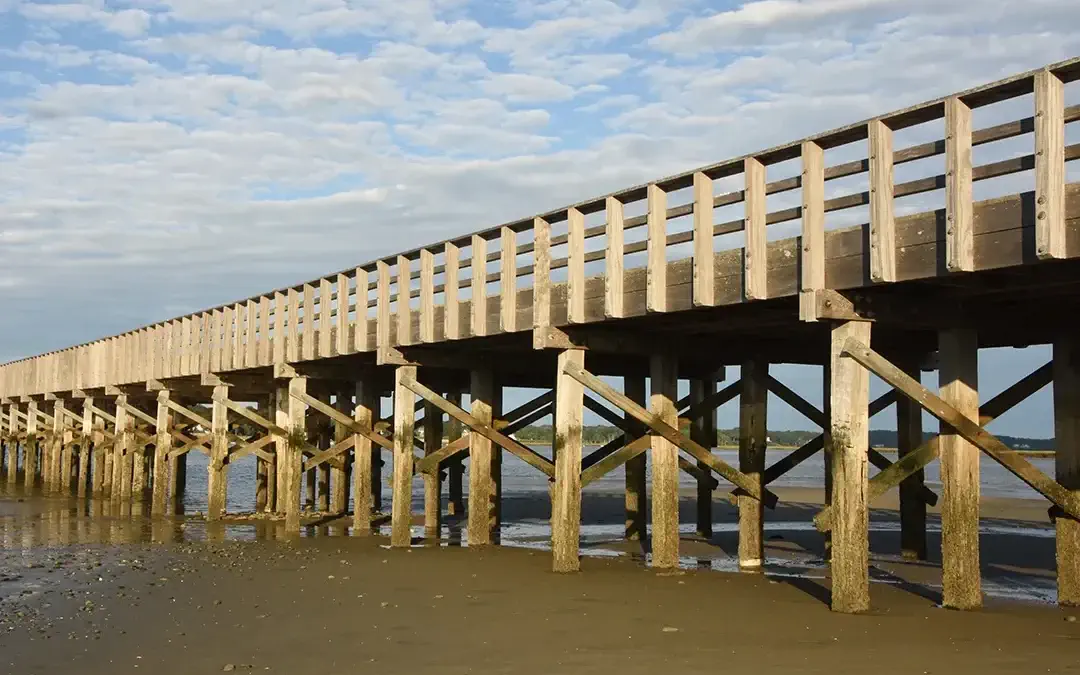Choosing the right foundation is crucial to a structure’s durability and safety. In this article, we’ll break down everything you need to know about pier and beam foundations, the role of piles and beams, and how they differ. We’ll also explore real-world examples—including Diamond Pier foundations—to help you make informed decisions for your property in Long Island, Queens, or Brooklyn.
What is a Pier Foundation?
A pier foundation is a system where cylindrical columns (piers) support the structure by transferring load deep into the ground. These piers are spaced strategically and are commonly made from concrete, brick, stone, or steel.

A diagram showing a pier system installation in a foundation
Where Are Pier Foundations Used?
Pier foundations are typically used when:
- Surface soil lacks strength
- The site is on uneven or sloped terrain
- Flooding is a concern (common in coastal areas)
- The structure is relatively light (homes, decks, sheds)
These foundations are a key component of pier and beam foundation systems, where piers hold up horizontal beams that support the floor structure.
Modern Example: Diamond Pier Foundations
A newer innovation is the Diamond Pier foundation, which uses pre-formed concrete headpieces set above ground, secured by long steel pins driven into the soil. These are especially useful for:
- Fast installation
- Minimal site disturbance
- Tight spaces or environmentally sensitive areas
What is a Pile Foundation?
Pile foundations are deep foundations used when surface soil is too weak for even pier-based systems. Piles—long columns made of concrete, steel, or wood—are driven deep into the earth to transfer the load to stable soil or bedrock.

A diagram showing a pile system installation in a foundation
Where Are Pile Foundations Used?
Pile foundations are common in:
- High-rise buildings
- Bridges and overpasses
- Marine structures (piers, docks)
- Industrial and infrastructure projects
Modern Example: Urban & Coastal Construction
In areas like Manhattan and coastal Long Island, pile foundations are used for large buildings that need to rest on firm soil far beneath the surface. They ensure structural stability in soft, compressible soils.
What is a Beam in a Foundation?
In a pier and beam foundation system, the beam is the horizontal structural element that spans across the tops of piers. It supports the floor joists and distributes the load evenly.

A picture of a beam foundation
Where Are Beams Used in Foundations?
Beams are used in combination with:
- Piers (as in pier and beam systems)
- Piles (deep beam-pile foundations)
- Grade beams in shallow foundations
This system is still common in older homes in Brooklyn, Queens, and parts of Long Island, offering easy access to crawl spaces and utilities.
Modern Example: Pier and Beam Foundation Repair
During home renovations or pier and beam foundation repair, damaged beams are often replaced to fix sagging floors or to reinforce aging structures.
Key Differences Between Pier, Pile, and Beam Foundations
| Feature | Pier Foundation | Pile Foundation | Beam (in Foundations) |
|---|---|---|---|
| Depth | Shallow to moderate | Deep (can reach bedrock) | Horizontal structural element |
| Best for | Residential/light loads | Heavy commercial loads | Load distribution |
| Soil Conditions | Fair to poor soils | Weak or compressible soils | Dependent on piers/piles |
| Material | Concrete, stone, steel | Concrete, steel, timber | Wood, concrete, steel |
| Example Use | Decks, homes, sheds | Skyscrapers, bridges | Crawl spaces, subfloor support |
Foundation Types in Long Island, Brooklyn, Queens & the Bronx
The type of foundation used in Long Island, Brooklyn, Queens, and The Bronx depends heavily on soil composition, water table levels, and urban density. Here’s a breakdown of the most prevalent foundation types in each area:
🧱 1. Long Island
Soil & Environment:
- Mix of sandy, loamy, and clay soils
- High water table in many areas (especially near the South Shore)
- Some areas prone to flooding and coastal erosion
Common Foundation Types:
- Pier and Beam Foundations – Used in older homes and flood-prone zones like the South Shore and Fire Island.
- Slab-on-Grade Foundations – Common in ranch-style homes, especially where the water table is too high for a basement.
- Crawl Space Foundations – Offers protection from moisture and easy access to utilities.
🧱 2. Brooklyn
Soil & Environment:
- Dense urban fill, clay-heavy soils in some areas (e.g., Red Hook, Gowanus)
- Older housing stock
- Moderate water table depending on neighborhood
Common Foundation Types:
- Full Basements with Masonry Walls – Very common in brownstones and rowhouses.
- Pile Foundations – Used in newer mid-rise and high-rise construction, especially near the waterfront or on reclaimed land.
- Slab-on-Grade – Found in newer single-family and low-rise developments.
🧱 3. Queens
Soil & Environment:
- Variable soil: clay, silt, sand
- Areas like Jamaica and Flushing have poorly draining soils
- Some coastal zones with high water tables (e.g., Rockaways)
Common Foundation Types:
- Basement Foundations – Widely used in traditional homes for utility space and storage.
- Pier and Beam – Still present in older homes and flood-prone areas.
- Pile Foundations – Used in commercial and multifamily buildings where deep support is needed.
🧱 4. The Bronx
Soil & Environment:
- Rocky terrain, bedrock close to surface in many parts
- Mix of glacial till, clay, and loam
- Less prone to flooding in inland areas
Common Foundation Types:
- Shallow Footings on Bedrock – In northern parts where rock is close to the surface.
- Pile Foundations – Especially in high-rise construction and projects near the Harlem River or East River.
- Basement Foundations – Used in both single- and multi-family residential buildings.
✅ Summary Chart:
| Area | Common Soil | Prevalent Foundations |
|---|---|---|
| Long Island | Sand, clay, high water table | Slab-on-grade, pier and beam, crawl space |
| Brooklyn | Urban fill, clay | Basement, pile, slab-on-grade |
| Queens | Mixed (clay, silt, sand) | Basement, pile, pier and beam |
| The Bronx | Rocky, glacial till | Bedrock footings, pile, basement |
Why Pier and Beam Foundations Are Still Relevant
Pier and beam foundations remain a preferred system in many homes throughout Queens, Brooklyn, and Long Island, thanks to:
- Easier plumbing and electrical access
- Better flood resilience
- Affordable repairs and retrofits
At Zavza Seal LLC, we offer expert services for pier and beam foundation repair, including leveling, beam replacement, and moisture control. Our team also installs modern options like Diamond Pier foundations for residential and light commercial projects.
Final Thoughts
Whether you’re building a new home or restoring an older one, understanding the differences between pier, pile, and beam foundations can help you choose the most reliable option.
For trusted, local expertise in foundation piers, Diamond Pier foundations, or pier and beam foundation repair, contact Zavza Seal LLC—your go-to contractor in Long Island, Brooklyn, and Queens.








